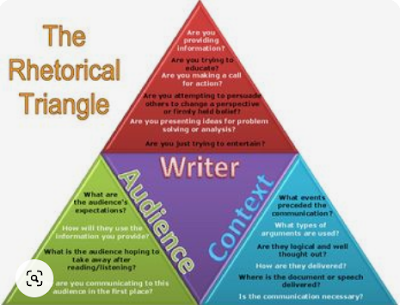Monday, April 26 to Friday, April 30 Introduction Rhetorical Devices Unit
Monday, April 26
Three parts: the speaker/ writer
the message
the audience
Everytime you (the speaker/ writer) wants to convey a message to someone (the audience /the person you are writing or speaking to), you use a rhetorical argument to make your point, The basic three methods of making an argument are logos (logic), ethos (ethics, what is right or wrong) and pathos (emotion).
A rhetorical device is a linguistic (verbal) tool that employs a particular type of sentence structure, sound, or pattern of meaning in order to evoke a particular reaction from an audience. Each rhetorical device is a distinct tool that can be used to construct an argument or make an existing argument more compelling.
To paraphrase: Someone wants you to do something and will convince you to do that thing, based upon the words they carefully choose.
Any time you try to inform, persuade, or argue with someone, you’re engaging in rhetoric. If you’ve ever had an emotional reaction to a speech or changed your mind about an issue after hearing a skilled debater's rebuttal (counter argument), you've experienced the power of rhetoric. By developing a basic knowledge of rhetorical devices, you can improve your ability to process and convey information while also strengthening your persuasive skills. In other words, you might be able to get someone to do what you want!
Types of Rhetorical Devices
Rhetorical devices are loosely organized into the following three categories:
- Logos. Devices in this category seek to convince and persuade via logic and reason and will usually make use of statistics, cited facts, and statements by authorities to make their point and persuade the listener.
- Pathos. These rhetorical devices base their appeal in emotion. This could mean invoking sympathy or pity in the listener, or making the audience angry in the service of inspiring action or changing their mind about something.
- Ethos. Ethical appeals try to convince the audience that the speaker is a credible source, that their words have weight and must be taken seriously because they are serious and have the experience and judgment to decide what is right.

Day 3, Thursday, April 29 Rhetorical
practice. Below is the vocabulary list from today’s class, followed by ten
practice sentences. Copy and paste the following onto a google doc and share OR pull it from google classroom.Select the non-Aristotelian
device used. Obviously, you will not use everyone on the list.
DUE BY MIDNIGHT FRIDAY, APRIL 30!
Aristotelian Appeals
1. logos appeals to the head using logic, numbers,
explanations, and facts. Through Logos, a writer aims at a
person's intellect. The idea is that if you are logical, you will understand
2. ethos appeals to the conscience, ethics, morals,
standards, values, principles
3. pathos appeals to the heart, emotions, sympathy,
passions, sentimentality.
***********************************************
4. onmatopoeia- using sound effects "punch, buzz, whisper, pizazz"
5. rhetorical question-a question asked in order to create a
dramatic effect or to make a point rather\ than to get an answer.
*6. anaphora- repeating the same phrases or clauses at the
beginning of a sentence
*7. epistrophe-the repetition of a word at the end of
successive clauses or sentences.
8. simile- using like our as to make a comparison
9. metaphor- making a direct comparison with a form of the
verb to be. (He is / they are/ "Love is an open door."
10.alliteration-the occurrence of the same letter or sound
at the beginning of adjacent or closely connected words. "shining,
shimmering, splendid"
11. synecdoche-a figure of speech in which a part is made to
represent the or vice versa "a pair
of glasses walked into the room";
in the video: comparing this dinner to all French dinners; the Braves
beat the Sox (Braves and Sox refer to
the whole teams.
12. antithesis- someone who is the direct opposite of
someone or something else
13. imagery- remember the five types: seeing (visual),
hearing (auditory), smelling (olfactory), tasting
(gustatory), feeling (sensual)
14. irony an
expression, often humorous or sarcastic, that exposes contrarines or absurdity
15. counterpoints
contrasting ideas such as black/white, darkness/light, good/bad
16.hyperbole- exaggeration
17. litotes- understatement in which an affirmative is
expressed by the negative of its contrary (e.g., you won't be
sorry, meaning you'll be glad
18. analogy - the
comparison of two pairs that have the same relationship. Unlike a metaphor,
which is poetic, an analogy is used to explain something.
19. apostrophe interruption of thought to directly address
a person or a personification: “So, I ask you, dear reader, what would you have
me do?”
Practice
1. 1. ________________________ The captain shouted, “We need all hands on
deck now.”
2. 2. _________________________ "That's one small step for man, one giant leap for
mankind." - Neil Armstrong.
3. _______________________ Peter Piped Picked a Peck of Pickled Peppers.
4. 4. ______________________ Rice Krispies is known
for its “snap, crackle and pop.”
5. 5. ______________________ We’ve been lost for
hours. He doesn’t have the best sense of direction.
6. 6. ____________________ It was the best of times, it was the worst of
times, it was the age of wisdom, it was the age of foolishness.
7. 7. _____________________This shopping cost me a
million dollars.
8. 8. _____________________ Life is a box of
chocolates.
9. 9. _____________________ Twinkle, twinkle little
star, how I wonder what you are or Roll on thou deep blue sea.
1 10. _____________________ Silence was broken by the
peal of piano keys as Shannon began practicing her concerto.





Comments
Post a Comment